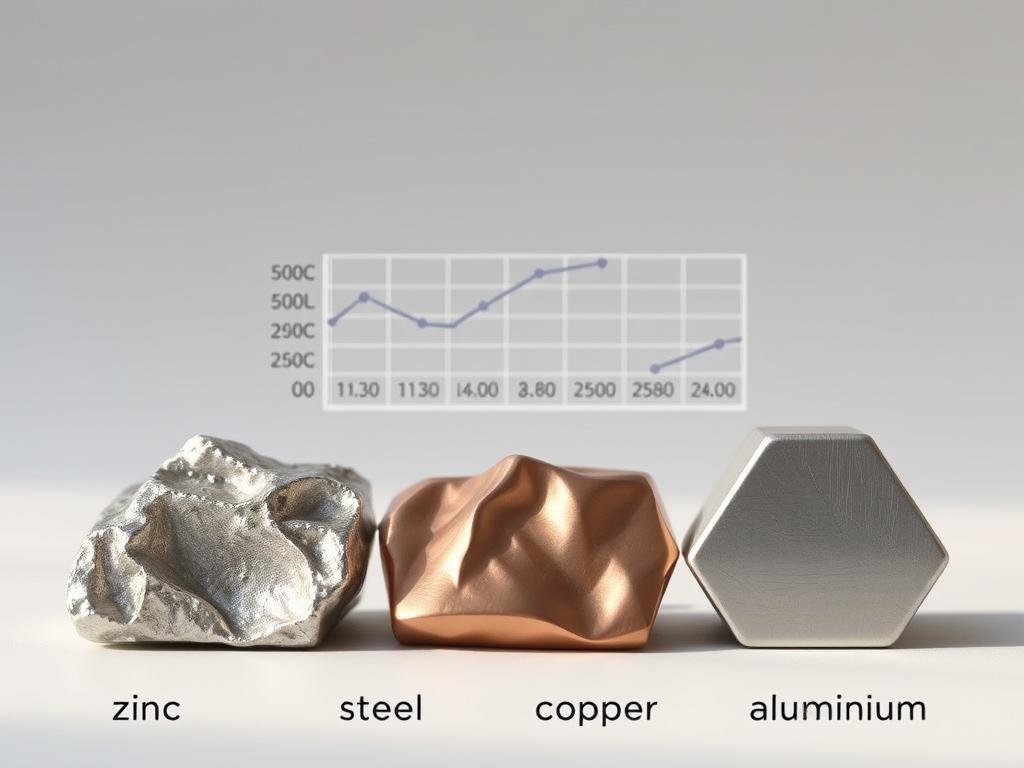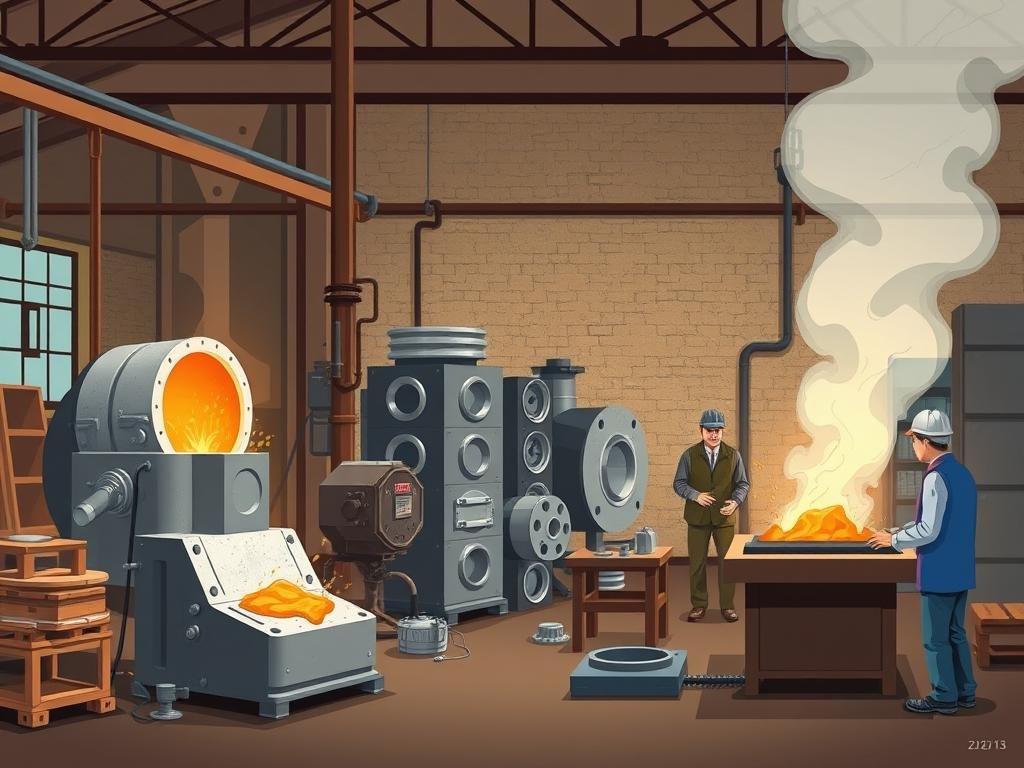Zinc is a versatile metal with a density of approximately 7.14 g/cm³ at room temperature, making it a relatively heavy metal compared to others like aluminum, but lighter than metals such as lead.
This comprehensive guide will explore the fundamental properties of zinc, including its atomic structure and position in the periodic table, to provide context for understanding its density characteristics and various industrial applications in materials manufacturing.
Understanding zinc’s properties is crucial for its effective use in different industries, from construction to manufacturing, where its density plays a critical role in material selection and performance.
The Fundamental Properties of Zinc
Zinc, a transition metal with atomic number 30, exhibits unique properties that make it invaluable in various industrial applications. Understanding zinc’s fundamental properties is crucial for appreciating its role in different industries.
Physical Characteristics and Atomic Structure
Zinc has an electronic configuration of [Ar]3d104s2, with two outer shell electrons that reduce its reactivity. This configuration contributes to its stability and characteristic metallic bonding, which influences its density, malleability, and ductility. The element naturally occurs in five stable isotopes, with zinc-64 being the most abundant, accounting for approximately 49% of naturally occurring zinc.
Zinc’s Position in the Periodic Table
Zinc occupies a strategic position in the periodic table as a transition metal in group 12, alongside cadmium and mercury. Its position helps explain its chemical properties and characteristic metallic bonding. The filled d-orbital in zinc’s electronic structure provides stability, making it less reactive compared to other metals.
Understanding the Density of Zinc
The density of zinc is a critical property that influences its applications across various industries. Density, a fundamental physical property, is defined as mass per unit volume. It is a crucial factor in determining the suitability of materials for different applications.
What Is Density and How Is It Measured?
Density is measured by dividing the mass of a substance by its volume. The formula for density is ρ = m/V, where ρ is density, m is mass, and V is volume. In the context of zinc, understanding its density is vital for calculating material requirements in manufacturing processes.
Zinc’s Density Value: 7.14 g/cm³
At room temperature, zinc has a density of 7.14 g/cm³, or 7,140 kg/m³. This density results from zinc’s hexagonal close-packed (HCP) crystal structure, which has a packing efficiency of approximately 74%. The HCP structure allows zinc atoms to fit closely together, making it a relatively dense metal. Some key points about zinc’s density include:
- Zinc’s density of 7.14 g/cm³ places it in the medium-density range among metals, making it suitable for applications requiring moderate weight.
- The density value is significantly higher than that of lightweight metals like aluminum but lower than heavy metals like lead.
- Understanding zinc’s density is essential for predicting the weight of zinc-based components and calculating material requirements.
Factors Affecting Zinc Density
Several key factors can affect the density of zinc, making it crucial to understand their impact on this versatile metal. The density of zinc is not constant and can be influenced by various external and internal factors.
Temperature Dependence
The density of zinc varies with temperature due to its thermal expansion properties. As temperature increases, zinc expands, and its density decreases. This relationship is critical in applications where zinc is exposed to varying temperatures.
Pressure Effects and Impurities
Pressure has a direct impact on zinc’s density; higher pressure compresses the atoms closer together, increasing the density. This is represented by the formula ρ(P)=ρ0 ×(1+κ(P−P0)), where ρ0 is initial density, κ is compressibility, and P is pressure. The presence of impurities also significantly affects zinc’s density. Elements like lead, iron, and cadmium can alter the density; heavier impurities increase it, while lighter ones decrease it.
- The type and concentration of impurities can cause variations in zinc’s density, impacting its performance in precision applications.
- Quality control processes are essential to monitor and control impurity levels, ensuring consistent density specifications.
Comparing Zinc Density to Other Metals
Understanding how zinc density compares to other metals is crucial for selecting the right material for various industrial applications. Zinc’s density of 7.14 g/cm³ positions it as a medium-density metal.
Zinc vs. Lightweight Metals
Compared to lightweight metals like aluminum (2.7 g/cm³) and magnesium (1.8 g/cm³), zinc is denser. This difference in density makes zinc more suitable for applications requiring higher strength and durability. For instance, zinc alloys are often used in die casting for producing parts that need to withstand significant stress.

Zinc vs. Heavy Metals
Zinc is less dense than heavy metals such as iron (7.87 g/cm³), copper (8.96 g/cm³), and lead (11.34 g/cm³). This characteristic gives zinc an advantage in applications where weight is a concern, but strength and corrosion resistance are still necessary. For example, zinc is used as a coating for steel (galvanization) to provide corrosion protection without significantly adding weight. Additionally, zinc’s density being about 20% less than copper makes it a more economical choice for certain applications where copper’s superior electrical conductivity is not required.
Zinc Alloys and Their Density Properties
Alloying zinc with other elements can significantly alter its density, making it suitable for a wide range of applications. This modification in density is primarily due to the inherent density of the alloying elements and their effect on the crystal structure of zinc.
Common Zinc Alloys: Zamak and ZA Series
Zamak and ZA series are notable zinc alloys that exhibit distinct density properties. For instance, Zamak 3, which contains 96% zinc and 4% aluminum, has a density of 6.6 g/cm³. The addition of aluminum reduces the overall density, making it a lighter option compared to pure zinc.
How Alloying Elements Affect Density
The density of zinc alloys is influenced by the alloying elements through two primary mechanisms: substitutional alloying and interstitial alloying. Elements like aluminum (density: 2.7 g/cm³) decrease the overall density, while copper (density: 8.96 g/cm³) increases it. The relationship between alloy composition and density is generally linear, following the rule of mixtures.
- Alloying elements significantly influence zinc’s density through their inherent density and effect on the crystal structure.
- The precise control of alloy composition allows manufacturers to engineer materials with specific density properties.
Measuring and Calculating Zinc Density
Accurate measurement of zinc density is crucial for various industrial applications. The density of zinc affects its performance in different processes, including casting and coatings.
Laboratory Techniques for Density Measurement
In laboratory settings, density measurement techniques are employed to ensure precision. Methods include using density cups and pycnometers to measure the mass and volume of zinc samples accurately.
Practical Methods for Industrial Applications
In industrial settings, practical methods are used to measure zinc density efficiently. Some common techniques include:
- Using automated systems integrated into production lines for real-time quality control.
- Employing density cups to compare the mass of molten zinc to a standard during casting operations.
- Utilizing ultrasonic density meters for non-destructive testing of finished zinc components.
Process control is vital in maintaining the desired density of zinc parts. Factors such as temperature, pressure, and impurities must be monitored and controlled. Variations in density can impact the performance of zinc during applications like casting.
| Method | Description | Application |
|---|---|---|
| Density Cups | Compare mass of molten zinc to a standard | Casting Operations |
| Ultrasonic Density Meters | Use sound wave propagation to determine density | Finished Zinc Components |
| Automated Systems | Integrated into production lines for real-time quality control | Industrial Production |

Industrial Applications of Zinc Based on Density
Zinc’s moderate density makes it an ideal material for numerous industrial applications. Its balanced density provides strong, durable protection without being too heavy, making it easy to install and handle.
Die Casting Applications

Zinc die casting is a popular method for producing high-precision components. Its density allows for the creation of complex geometries with excellent surface finish.
Galvanization and Corrosion Protection
Zinc’s density contributes to its effectiveness in galvanization, providing a robust layer of corrosion protection for steel. This process extends the lifespan of steel structures.
Zinc in Construction and Manufacturing
Zinc’s density makes it suitable for various construction and manufacturing applications, including roofing, cladding, and precision components. Its density ensures durability and performance.
The applications of zinc are diverse, ranging from architectural features like roofing and cladding to industrial components where weight distribution is critical. Zinc’s density-to-strength ratio makes it valuable in structural applications where aluminum would be too light and steel too heavy.
Conclusion
Zinc’s density is a fundamental property that influences its use across various industries. With a density of 7.14 g/cm³, zinc is positioned between lightweight and heavy metals, making it uniquely suited for applications requiring balanced weight and performance characteristics.
The importance of zinc’s density is evident in its diverse applications, from die casting and galvanization to construction and manufacturing. By modifying zinc through alloying, temperature control, and processing techniques, a spectrum of materials with tailored properties can be created for specific engineering challenges.
Understanding and controlling zinc density is crucial for quality control in industrial processes, ensuring consistent performance in critical applications where weight, strength, and corrosion resistance must be precisely balanced. As material science advances, zinc and its alloys continue to find new applications, demonstrating the ongoing relevance of this versatile material.
